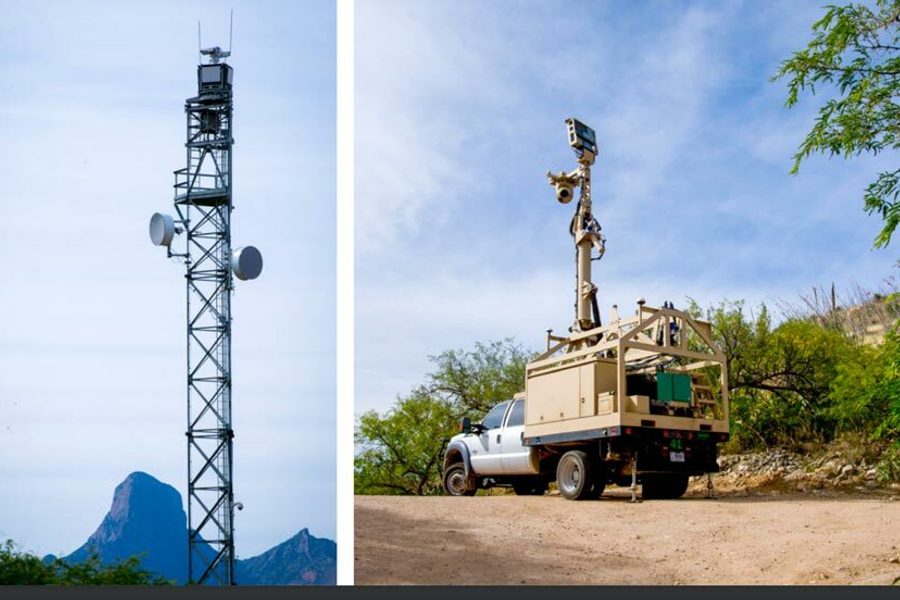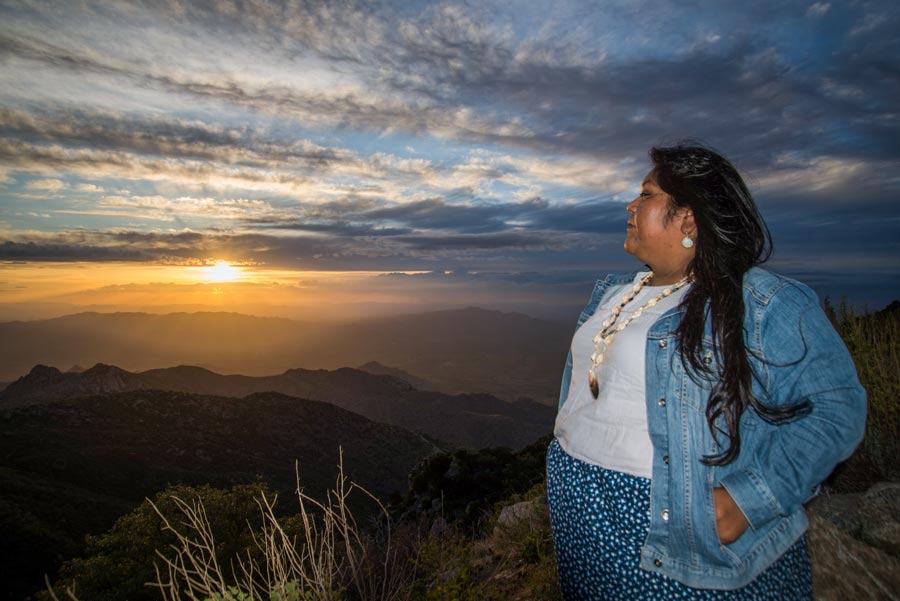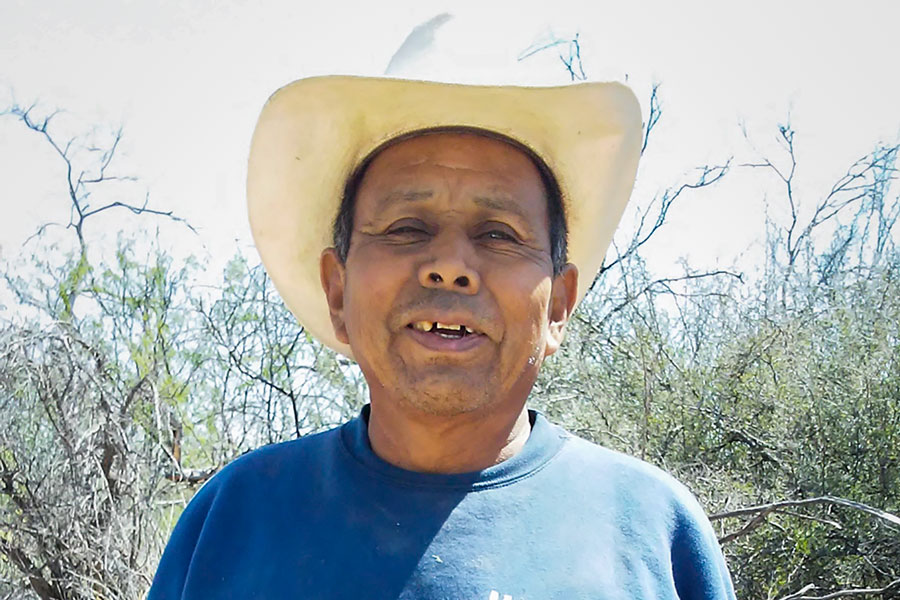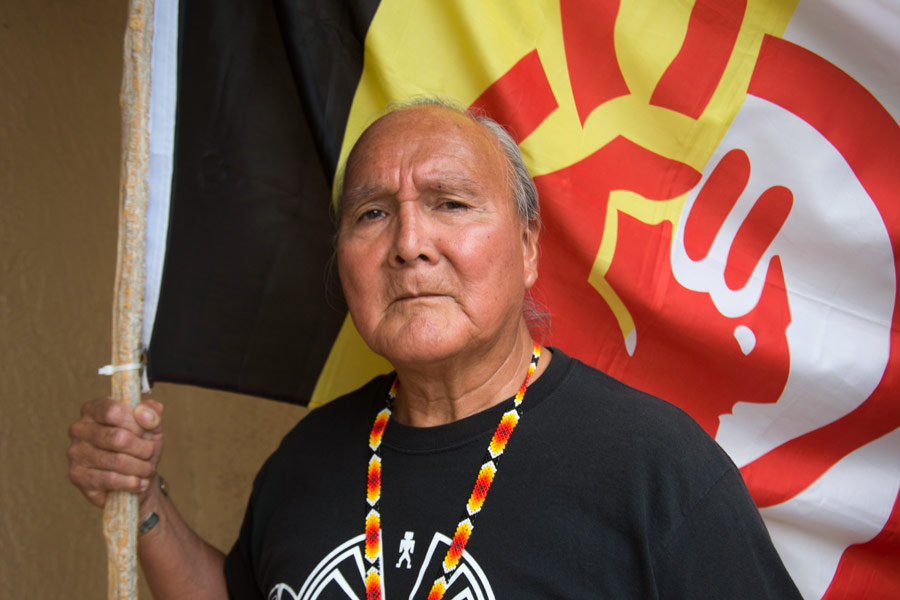How Border Patrol Occupied the Tohono O’odham Nation
Under ever-expanding high-tech surveillance, the reservation has become “the most militarized community in America.”
Todd Miller

TOHONO O’ODHAM NATION, ARIZ. — In March 2018, Joaquin Estevan was on his way back home to Sells, Ariz., after a routine journey to fetch three pots for ceremonial use from the Tohono O’odham community of Kom Wahia in Sonora, Mexico (where he grew up) — a trek his ancestors have made for thousands of years. His cousin dropped him off on the Mexico side of the San Miguel border gate, and he could see the community van of the Tohono O’odham Nation waiting for him just beyond.
But when Estevan handed over his tribal card for identification, as he had done for years, to the stationed Border Patrol agent, he was accused of carrying a fraudulent ID, denied entry to Arizona and sent back to Mexico.
Tohono O’odham aboriginal land, in what is now southern Arizona, historically extended 175 miles into Mexico, before being sliced off — without the tribe’s consent — by the 1853 Gadsden Purchase. As many as 2,500 of the tribe’s more than 30,000 members still live on the Mexico side. Tohono O’odham people used to travel between the United States and Mexico fairly easily on roads without checkpoints to visit family, go to school, visit a doctor or, like Estevan, a traditional dancer, perform ceremonial duties.
But incidents of U.S. Customs and Border Protection (CBP) aggression toward members of the Tohono O’odham Nation have become increasingly frequent since 9/11, as Border Patrol has doubled in size and further militarized its border enforcement. In 2007 and 2008, the United States built vehicle barriers on the Tohono O’odham Nation’s stretch of the U.S.-Mexico border, and restricted crossings.
The Tohono O’odham’s struggles with Border Patrol received little attention, however, until President Donald Trump took office and pushed forward his vision for a wall along the border. Verlon Jose, Tohono O’odham vice chairman, announced in 2016 that the wall would be built “over my dead body,” a quote that went viral.
What the border wall debate has obscured, however, is the existing 650 miles of walls and barriers on the U.S. international divide with Mexico, including the 62 miles of border that run through the Tohono O’odham Nation. An increasingly significant part of that wall is “virtual,” a network of surveillance cameras, sensors and radar systems that let Border Patrol agents from California to Texas monitor the remote desert stretches where border crossers have been deliberately pushed — a strategy that has led to thousands of migrant deaths in the dangerous desert terrain. The virtual wall expands away from the international boundary, deep into the interior of the country.
As Trump fights Congress and the courts to get $5 billion in “emergency funding” for a border wall, Border Patrol is already tapping into existing funds to expand both physical and virtual walls. While new border barrier construction on the Tohono O’odham Nation remains in limbo, new surveillance infrastructure is moving onto the reservation.
On March 22, the Tohono O’odham Legislative Council passed a resolution allowing CBP to contract the Israeli company Elbit Systems to build 10 integrated fixed towers, or IFTs, on the Nation’s land, surveillance infrastructure that many on the reservation see as a high-tech occupation.
The IFTs, says Amy Juan, Tohono O’odham member and Tucson office manager at the International Indian Treaty Council, will make the Nation “the most militarized community in the United States of America.”

Tohono O’odham Nation activist Amy Juan watches the sunset over Kitt Peak in southern Arizona, a sacred mountain known to the O’odham as loligam Doag. (Photo by Raechel Running)
Amy Juan and Nellie Jo David, members of the Tohono O’odham Hemajkam Rights Network (TOHRN), joined a delegation to the West Bank in October 2017 convened by the Palestinian organization Stop the Wall. It was a relief, Juan says, to talk “with people who understand our fears … who are dealing with militarization and technology.”
Juan and David told a group of women in the Palestinian community about the planned IFTs, and they responded unequivocally: “Tell them no. Don’t let them build them.”
The group was very familiar with these particular towers. Elbit Systems pioneered the towers in the West Bank. “They said that the IFTs were first tested on them and used against them,” says David. Community members described the constant buzzing sounds and the sense of being constantly watched.
These IFTs are part of a broader surveillance apparatus that zigzags for hundreds of miles through the West Bank and includes motion sensor systems, cameras, radar, aerial surveillance and observation posts. In distant control rooms, soldiers monitor the feeds. The principal architect, former Israeli Col. Danny Tirza, explained in 2016, “It’s not enough to construct a wall. You have to construct all the system around it.”
That is happening now in the U.S.-Mexico borderlands.
The massive post-9/11 bolstering of border enforcement dramatically changed life on the Tohono O’odham Nation. At a UN hearing in January on the rights of indigenous peoples in the context of borders, immigration and displacement, Tohono O’odham Nation Chairman Edward Manuel testified that when he came back to the Nation in 2009 after six years living off-reservation, it had become “a military state.”
Border Patrol has jurisdiction 100 miles inland from U.S. borders, giving it access to the entirety of the reservation. Drones fly overhead, and motion sensors track foot traffic. Vehicle barriers and surveillance cameras and trucks appeared near burial grounds and on hilltops amid ancient saguaro forests, which are sacred to the Tohono O’odham.
“Imagine a bulldozer parking on your family graveyard, turning up bones,” then-Tohono O’odham Nation Chairman Ned Norris Jr. testified to Congress in 2008. “This is our reality.”
Around 2007, CBP began installing interior checkpoints that monitored every exit from the reservation — not just on the U.S.-Mexico border, but toward Tucson and Phoenix.
“As a person who once could move freely on our land, this was very new,” Amy Juan says. “We have no choice but to go through the armed agents, dogs and cameras. We are put through the traumatic experience every day just to go to work, movies, grocery shopping, to take your children to school.”
Juan calls this “checkpoint trauma.” The most severe impact is on children, she says, recalling one case in which two kids “wet themselves” approaching a checkpoint. Previously the children had been forcefully pulled out of a car by Border Patrol agents during a secondary inspection.
Pulling people out of their vehicles is one in a long list of abuses alleged against the Border Patrol agents on the Tohono O’odham Nation, including tailing cars, pepper spraying people and hitting them with batons. Closer to the border, people have complained about agents entering their homes without a warrant.
In March 2014, a Border Patrol agent shot and injured two Tohono O’odham men after their truck sideswiped his vehicle. (The driver said he was swerving to avoid a bush and misjudged; Border Patrol charged him with assault with a deadly weapon.) In 2002, a Border Patrol agent ran over and killed a Tohono O’odham teenager.
Between checkpoints and surveillance, there is a feeling of being “watched all the time,” Tohono O’odham member Joseph Flores told Tucson television station KVOA.
“I’ve gotten flat tires, then when I come to the checkpoint the agents made comments about me having a flat earlier in the day,” says Joshua Garcia, a member of TOHRN. “I felt like they were trying to intimidate me.”
An anonymous respondent to TOHRN’s O’odham Border Patrol Story Project said, “One time a BP told me, ‘We own the night,’ meaning that they have so much surveillance cameras and equipment on the rez, they can see everything we do all the time.”
Undocumented migrants are the ostensible targets, but agents have long indicated that Tohono O’odham are also in the crosshairs. One Tohono O’odham youth (who wishes to remain anonymous because of fears of reprisal) says that when they complained to a Border Patrol agent in February about a camera near their house, the agent responded, “It’s your own people that are smuggling, so you really need to ask yourself what is going on in that area for a camera to be set up in the first place.” That perception is common. Geographer Kenneth Madsen quotes an agent who believed as many as 80% to 90% of residents were involved in drug or human smuggling. Madsen believes the numbers could only be that high if agents were counting humanitarian acts, such as giving water to thirsty border-crossers.
Elder and former tribal councilman David Garcia acknowledges some “smuggling that involves tribal members.” As Tohono O’odham member Jay Juan told ABC News, there is “the enticement of easy money” in a place with a poverty rate over 40%.
Nation Vice Chairman Verlon Jose also told ABC, “Maybe there are some of our members who may get tangled up in this web. … But the issues of border security are created by the drugs … intended for your citizen[s’] towns across America.”

After a trip to Mexico to retrieve some ceremonial items, Tohono O’odham member Joaquin Estevan’s tribal ID card was rejected by U.S. Border Patrol agents, leaving him stranded. (Photo by David Garcia)
Estevan knew the agent who turned him back at the border — it was the same agent who had accused him of smuggling drugs years prior and who had ransacked his car in the search, finding nothing and leaving Estevan to do the repairs. A few days after being turned away, Estevan tried again to get home, crossing into the United States at a place known as the Vamori Wash — one of the planned locations for an IFT. He got a ride north from a friend (the kind of favor that Border Patrol might consider human smuggling). Eleven miles from the border on the crumbling Route 19, the same agent flashed his lights and pulled them over. According to Estevan, the agent yanked him out of the car, saying, “I told you that you were not supposed to come here,” and handcuffed him.
Estevan was transported to a short-term detention cell at Border Patrol headquarters in Tucson, where he was stripped of everything “except my T-shirt and pants,” he says. The holding cell was frigid, and Border Patrol issued him what he describes as a “paper blanket.” Estevan contracted bronchitis as he was shuffled around for days, having his biometrics and picture taken for facial recognition — Border Patrol’s standard practice for updating its database.
At one point, Estevan faced a judge and attempted to talk to a lawyer. But because he was not supplied a Tohono O’odham interpreter, he had only a vague idea of what was going on. Later, Estevan was taken 74 miles north to a detention center in Florence, Ariz., where the private company CoreCivic holds many of the people arrested by Border Patrol. Estevan was formally deported and banished from the United States. He was dropped off in the late afternoon in Nogales, Mexico.
Estevan is far from the only Tohono O’odham from Mexico to say they have been deported, although there has not been an official count. The Supreme Council of the O’odham of Mexico — which represents the Tohono O’odham who live on the Mexican side of the border — made an official complaint to the Tohono O’odham Nation’s government in May 2018, saying the Nation was “allowing the deportation of our people from our own lands.”
Some members of the Nation, such as Ofelia Rivas, of the Gu-Vo district, have long contended that the Legislative Council is too cozy with Border Patrol. Rivas said in a 2006 interview that the Nation “has allowed the federal government to control the northern territory [in the U.S.] and allows human rights violations to occur.” The Nation has received grants from the federal government for its police department through a program known as Operation Stonegarden. Over the years, the Legislative Council has voted to allow a checkpoint, surveillance tech and two Border Patrol substations (one a Forward Operating Base) on the reservation.
These tensions resurfaced again around the IFTs.
*****
In 2006, Border Patrol began to use southern Arizona as a testing ground for its “virtual wall.” The agency awarded the Boeing Company a contract for a technology plan known as SBInet, which would build 80-foot surveillance towers in the Arizona desert.
When Secretary of Homeland Security Janet Napolitano cancelled the plan in 2011, complaining about cost, delays and ineffectiveness, CBP launched a new project, the 2011 Arizona Border Surveillance Technology Plan. As part of it, Elbit Systems won a $145 million contract to construct 53 IFTs in 2014. As CBP’s Chief Acquisition Officer Mark Borkowski explained in 2017 at the San Antonio Border Security Expo, CBP sought technology that “already existed” elsewhere. Elbit, with its towers in the West Bank, fit the bill.
The IFTs take the all-seeing eye of Border Patrol to a whole new level. Jacob Stukenberg, a Border Patrol public information officer, tells In These Times they are “far superior than anything else we’ve had before,” adding that “one agent can surveil an area that it might take 100 agents on foot to surveil.”
The IFT system has high-definition cameras with night vision and a 7.5-mile radius, along with thermal sensors and a 360-degree ground-sweeping radar. The data feeds into command centers where agents are alerted if any of thousands of motion sensors are tripped. In an interview in May with the Los Angeles Times, Border Patrol tribal liaison Rafael Castillo compared IFTs to “turning on a light in a dark room.”
As with other monitoring, the towers — some as tall as 140 feet and placed very visibly on the tops of hills — have already driven migrants into more desolate and deadly places, according to a January paper in the Journal of Borderlands Studies. The first IFT went up in January 2015, just outside of Nogales, Ariz. By 2017, according to Borkowski, nearly all the towers had been built or were about to be built around Nogales, Tucson, Douglas, Sonoita and Ajo. The holdout was the Tohono O’odham Nation.
Between 2015 and 2018, Joshua Garcia of TOHRN gave more than 30 presentations around the Nation raising the negatives of the IFTs, including federal government encroachment on their lands, the loss of control over local roads, the potential health consequences and racism in border policing. “I didn’t expect people necessarily to agree with me,” Garcia says, “but I was surprised at how much the presentations resonated.”
Garcia joined other tribal and community members and Sierra Club Borderlands in contesting CBP’s 2016 draft environmental assessment — required for construction to begin — which claimed the IFTs would have “no significant impact” on Tohono O’odham land. Garcia listed the sites that new roads would threaten, like a saguaro fruit-harvesting camp and his own family’s cemetery.
The Sierra Club argued the assessment had failed to properly look at the impacts on endangered species, such as the cactus ferruginous pygmy owl and the lesser longnosed bat, and hadn’t adequately studied how electro-magnetic radiation from the towers might affect people, birds and other wildlife. CBP agreed that more study was needed of the “avian brain,” but issued its final report in March 2017: no significant impact.
In July 2017, the Gu-Vo district passed a resolution in opposition to the IFTs. “Having the land remain open, undeveloped and home to food production and wildlife, and carbon sequestration with natural water storage is crucial to the community,” the statement read.
At the March 22 Legislative Council meeting, Garcia, the tribal elder (and a close relative of Estevan), implored the Council not to approve the IFTs. He looked to Councilman Edward Manuel, who had two months earlier described the Border Patrol presence on the Nation as a “military state,” and said, “Veto it, if it passes.”
The resolution passed, without veto, although with a number of stipulations, including compensation for leased land.
Nation Vice Chairman Jose told the Los Angeles Times that the vote was intended to be a compromise to dissuade the federal government from building the wall. The Nation is “only as sovereign as the federal government allows us to be,” Jose said.
A Border Patrol spokesperson told the Los Angeles Times, however, that there are no plans to reduce agents, and that the IFTs do not eliminate the need for a wall.
*****
Garcia and other resisters are up against an enormous system. Trump’s plan has never been just about a border wall: The administration wants to fortify a massive surveillance apparatus built over multiple presidencies. Asked in February what he thought about the focus on the wall, Border Patrol’s Stukenberg said it was just one component of border infrastructure. Three things are required — fence, technology and personnel, he said, to build a “very solid system.”
The endeavor is certainly very profitable. Boeing received more than $1 billion for the cancelled SBInet technology plan. For the 49 mobile surveillance trucks now patrolling the border, CBP awarded contracts to the U.S.-based private companies FLIR Systems and Telephonics. Another contract went to General Dynamics to upgrade CBP’s Remote Video Surveillance Systems, composed of towers and monitoring systems. As of 2017, 71 such towers had been deployed in desolate areas of southern Arizona, including one on the Tohono O’odham Nation. Other major companies that have received CBP contracts include Northrop Grumman, Lockheed Martin, Raytheon and KBR (a former Halliburton subsidiary).
These companies wield tremendous lobbying power in Washington. In 2018, General Dynamics spent more than $12 million on lobbying and gave $143,000 in campaign contributions to members of the House Homeland Security Committee. To compare, the Tohono O’odham Nation spent $230,000 on lobbying and $6,900 on campaign contributions to the committee members in 2018.
Meanwhile, at the UN hearing in January, Serena Padilla, of the nearby Akimel O’odham Nation, described an incident in which Border Patrol agents held a group of youth at gunpoint. She ended her testimony: “As a woman who is 65 years old with four children, 15 grandchildren, 33 great-grandchildren — I’ll be damned if I won’t go down fighting for my future great-great-grandchildren.”

David Garcia, former Tohono O’odham tribal councilman and member of the O’odham Elder Council, holds the flag of the American Indian Movement, founded in 1968. Garcia sees the flag as a symbol of Native rights and continued resistance, from Wounded Knee to the borderlands. (Photo by Raechel Running)






